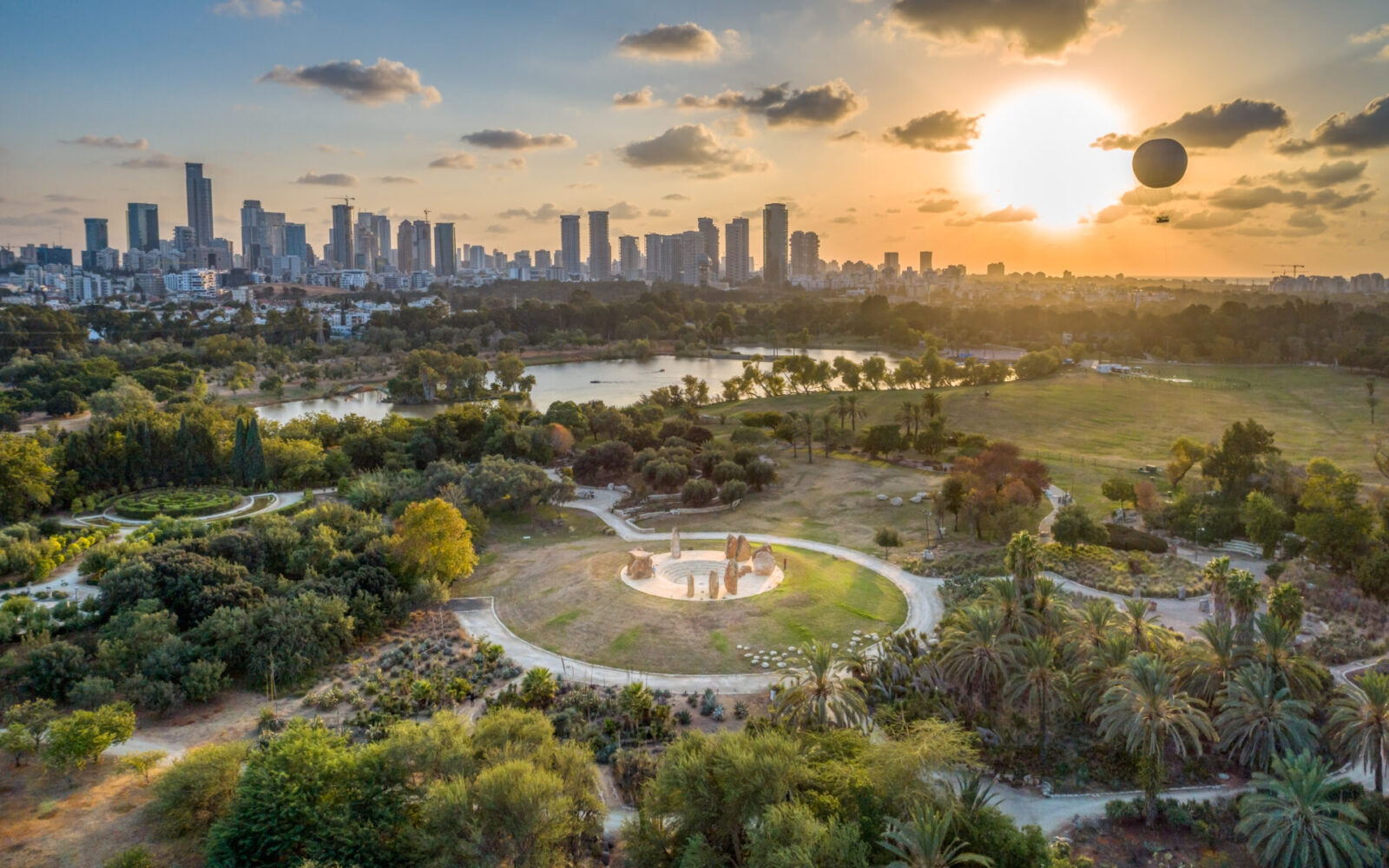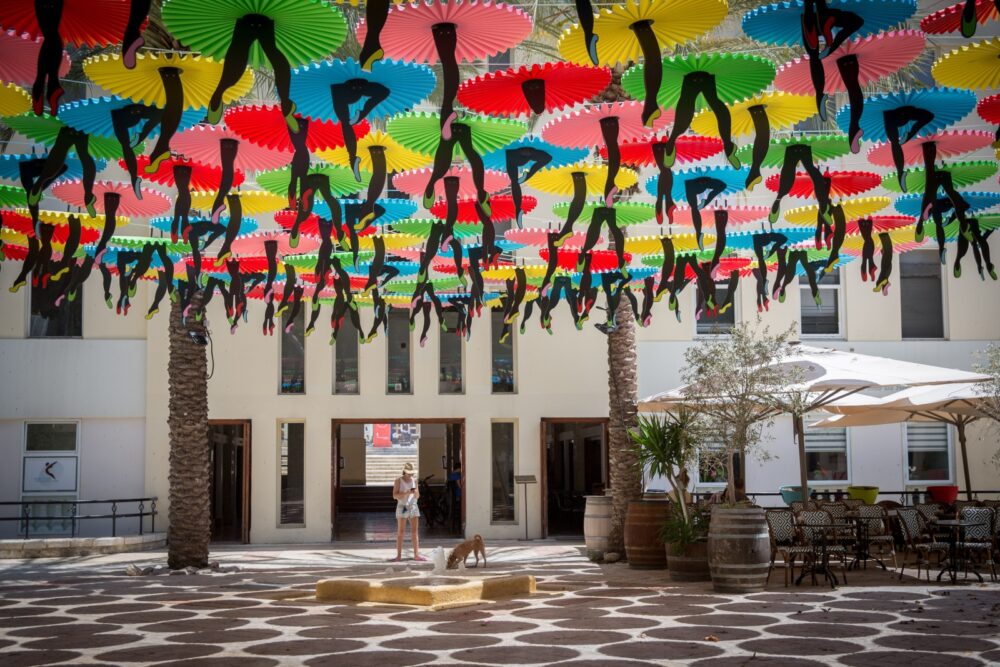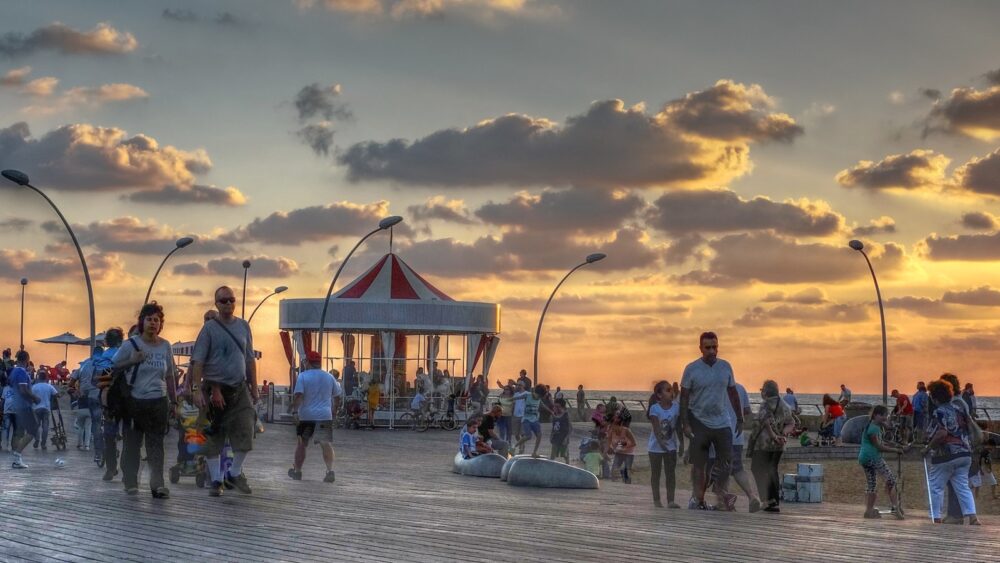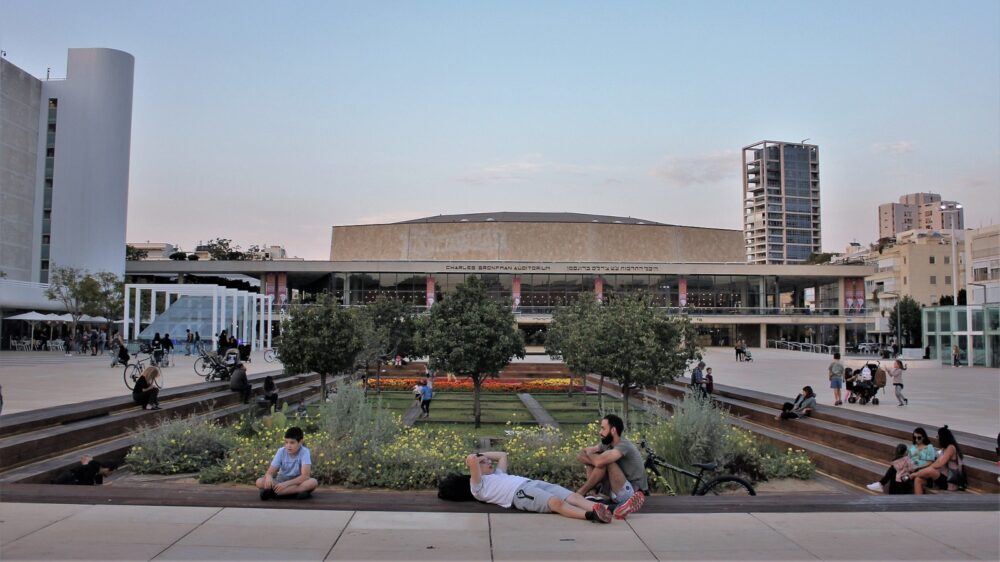Tourists love Tel Aviv. And it’s no wonder.
You’ve got a coastline full of Mediterranean beaches. You’ve got the best nightlife in the Middle East and some of the best restaurants anywhere.
Art, music, theater, dance? Endless options. Shopping? Choose from glitzy malls to the Jaffa Flea Market, from cutting-edge fashion designer studios to the multigenerational Carmel Market produce stalls.
Whether you are interested in history or recreation, architecture or high-tech, synagogues or gay bars, Tel Aviv has you covered.
And even though a recent survey found Tel Aviv ranks as the world’s most expensive city to live in, visitors will find plenty of things to do in Israel’s second largest city that don’t cost a single shekel.
Naturally, if you want to spend the night you’ll have to take out your wallet, but our Tel Aviv hotel guide can help you find accommodations that fit your budget and preferences.
Below are 18 absolutely free things to do in Tel Aviv.
- Beaches

Tel Aviv’s west side is a 13-kilometer (eight-mile) stretch of sandy beaches.
And although each of the 12 beaches has its own special character, you can’t go wrong no matter where you set down your towel.
Gordon Beach is one of the most famous, attracting tourists, locals, joggers and sun-tanners all year round. Stop by Saturday (11am to 2pm in winter, 7-11pm in summer) and give public Israeli folk dancing a whirl.
Banana Beach, located on the southernmost edge near Jaffa, draws the bohemian crowds on Friday evenings for drum circles, singing and dancing.
Metzizim Beach draws a smattering of everyone to its sandy shores. Catch a game of matkot (paddleball) or bring your kids to the children’s playground.
The rainbow umbrellas on Hilton Beach (near the hotel of the same name) mark this as the most gay-friendly beach, while Nordau Beach offers gender-separate days for the Orthodox community.
So pack your lotion, towel and good book to read – sandy Tel Aviv on the shoreline of the Mediterranean Sea awaits.
- Tel Aviv-Jaffa seaside promenade

The Tel Aviv-Jaffa promenade is a bustling beach boardwalk stretching from Old Jaffa in the south to the Tel Aviv Port in the north.
Walk, bike or scooter your way along the promenade to enjoy gorgeous sea views, breathtaking sunsets, music buskers and some of the best people-watching anywhere on the planet.
- Yarkon Park

This “Central Park of Tel Aviv” on the Yarkon River attracts some 16 million visitors every year.
The urban park’s 3.8 square kilometers boast walking paths, bike paths, dozens of children’s play areas, botanical gardens, extensive lawns, sports facilities, two mini zoos and artificial lakes.
The park also houses paid entertainment options including a bird park, water park, climbing wall, children’s train and paddleboats.
- Independence Trail

Independence Trail is a free self-guided walking tour that links 10 landmarks and themes related to Independence Hall in Tel Aviv.
The one-kilometer trail starts at the city’s first food kiosk on the corner of Herzl Street and Rothschild Boulevard, passes by significant sites in the history of Tel Aviv and Israel between the founding of Tel Aviv, the first Hebrew city, in 1909 and the establishment of Israel in 1948.
Just follow the brass strip embedded in the ground; it’s illuminated at night. Information is posted on signs along the trail in three languages, and maps are available for free in eight languages at the information booth on Rothschild Boulevard. You can also download a free GPS-based app for narration.
- Tel Aviv Greeter
The Tel Aviv branch of the International Greeter Association offers free two- to four-hour walks to numerous municipal destinations, led by local volunteers who just want to share their love of the city. No tipping allowed!
Tel Aviv Greeters can take you to museums, archeological sites, places to eat, nightlife, and hotspots such as Neve Tzedek, Nachalat Binyamin, the Yemenite Quarter, Tel Aviv Port, Yarkon Park, Florentin, Old Jaffa, Carmel Market and the beach promenade.
Register online at least five days (but not more than a month) ahead of your “Greet Date.”
- Bauhaus architecture

One of Tel Aviv’s nicknames is the White City, thanks to its large number of white Bauhaus (International-style) buildings. In 2003, the United Nations Educational, Scientific and Cultural Organization (UNESCO) proclaimed Tel Aviv’s White City a World Cultural Heritage site.
Every Saturday at 11am, the city offers a free walking tour of the best of Bauhaus along Rothschild Boulevard, starting at #11 next to the city’s first kiosk and streetlamp. In addition to admiring the buildings lining the boulevard, you’ll hear stories about the people who lived in them.
- Neve Tzedek and historic train station (Tachana)

Neve Tzedek is one of Tel Aviv’s most beautiful neighborhoods – and was the first neighborhood built outside of Jaffa. It’s perfect for a romantic stroll along the small streets and alleyways and past the beautifully restored buildings.
The Suzanne Dellal Center dance and theater complex sits at the heart of this neighborhood, and a visit to its courtyard is a must.
On the southern edge of the neighborhood is the historic train station known as the Tachana. This newly-restored compound now serves as a cultural and shopping center.
- Ben-Gurion House

One of the smallest museums and likely the most overlooked is Ben-Gurion House, a historic site at 17 Ben-Gurion Boulevard that served as an additional residence for Israel’s first prime minister, David Ben-Gurion.
Visitors can see Ben-Gurion’s library, his family’s sleeping quarters and the study where he worked. Take a free guided tour of the house in English and learn about Ben-Gurion’s life work. The House is open for individual and group visits daily.
Reservations: info@bg-house.org. Visitors who come without a scheduled group can receive an audio guide and pamphlet in English.
- Sarona Market

Originally a German Templer Colony, the Sarona Market complex in the heart of Tel Aviv’s central business district boasts some of the most beautiful restored and new architecture in the city, all in a beautifully landscaped setting. Opened in early 2014, Sarona is one of Tel Aviv’s hottest spots for dining and shopping – but you don’t have to spend any money to learn about its history in the visitor center, peruse the art galleries and culinary market, and wander around admiring the lush grounds.
Tel Aviv Global and Tourism offers a guided free walking tour of Sarona Market on Tuesdays at 11 (English tours must be booked in advance).
Bring a picnic, do some people-watching and take lots of photos.
- Trumpeldor Cemetery
The final resting place for many of Israel’s foremost politicians, poets and artists from first mayor of Tel Aviv Meir Dizengoff to iconic pop star Arik Einstein, Trumpeldor Cemetery is open to the public most days from 7am to 5pm.
- Charles Clore Park

The southern beachfront Charles Clore Park at the invisible seam of Tel Aviv and Jaffa is a perfect getaway spot. There are observation points overlooking the Jaffa seafront, a playground, barbeque area, outdoor gym, yoga deck, and jogging and biking lanes.
- Old Jaffa

No visit to Tel Aviv is complete without a hop over to Old Jaffa. It is one of the world’s oldest cities and home to the oldest seaport in the world.
In the last decade, Old Jaffa has become one of the hottest places to be as designers, artists and gourmands move in. Start at the famous Clock Tower and walk around to get the full flavor of the flea market, restaurants, designer stores, galleries and museums, Simon the Tanner’s House, Jaffa Port and the NaLaga’at Center for theater arts operated by the deaf and blind community.
- Tel Aviv Port

Tel Aviv Port is one of the city’s main leisure destinations with trendy shops, bars, nightclubs, cafés and farmers’ market. Thousands of residents and tourists walk along the uniquely designed wooden deck promenade to take in the salty sea breeze, gorgeous sunsets and unique vibe of Tel Aviv.
There’s a huge sand pit for kids to play in. Weekends are busiest, with buskers and balloon artists keeping the crowds entertained. The port also hosts numerous outdoor festivals throughout the year.
- Levinsky Market

Even if you buy nothing at Levinsky Market, this is a prime place for photos in Tel Aviv. The outdoor market is the place for spices, dried fruits, nuts, pastries, boutique cheeses, pickled produce, exotic cold cuts and salted fish.
If you time your visit for a Friday morning, you’ll find narrow Levinsky Street packed with Israelis doing their last-minute Shabbat shopping – providing not only good scenes for photos but also great people-watching.
- Culture Square

Tel Aviv is Israel’s culture city. Although most of the museums, orchestras, theaters, art galleries, dance venues and music halls charge an entry fee, you can get a taste of the city’s arts scene simply by walking around Culture Square at the end of Rothschild Boulevard.
Here you’ll find the historic Charles Bronfman Auditorium, home to the Israel Philharmonic Orchestra; Habima National Theater and the Helena Rubinstein Pavilion for Contemporary Art of the Tel Aviv Museum of Art (the pavilion is undergoing renovation and will reopen as the Eyal Ofer Building for the Arts). All these cultural touchpoints face a beautiful public courtyard with a small flower garden and water fountain, and a lovely public park is located nearby.
- Dizengoff Street
Strolling down Dizengoff Street is such a favorite pastime that there was even a Hebrew word coined for this activity – l’hizdangef.
For great people-watching or just a place to take a break, park yourself on one of the benches around the Agam Fire & Water Fountain in Dizengoff Square, where local artisans show off their wares.
- Tel Aviv Rollers
Every Tuesday night at 9:45 near Habima Theater, as many as 400 in-line skaters meet up to hit the streets in a loose confederation nicknamed the Tel Aviv Rollers.
Police escorts are on hand to keep the skaters safe as they zip along a 25- to 30-kilometer route through the city and environs. If you’re an experienced skater, don’t miss this high-energy fun. Cyclists are welcome to follow behind.
- Houses of worship
Tel Aviv-Yafo encompasses some of the most impressive houses of worship in Israel. The Cymbalista Synagogue and Jewish Heritage Center on the campus of Tel Aviv University, the neo-Gothic Immanuel Lutheran Church in Jaffa, or the Ottoman-era Hassan Bek Mosque in Jaffa are all good options, and all are open for free to visitors.

















